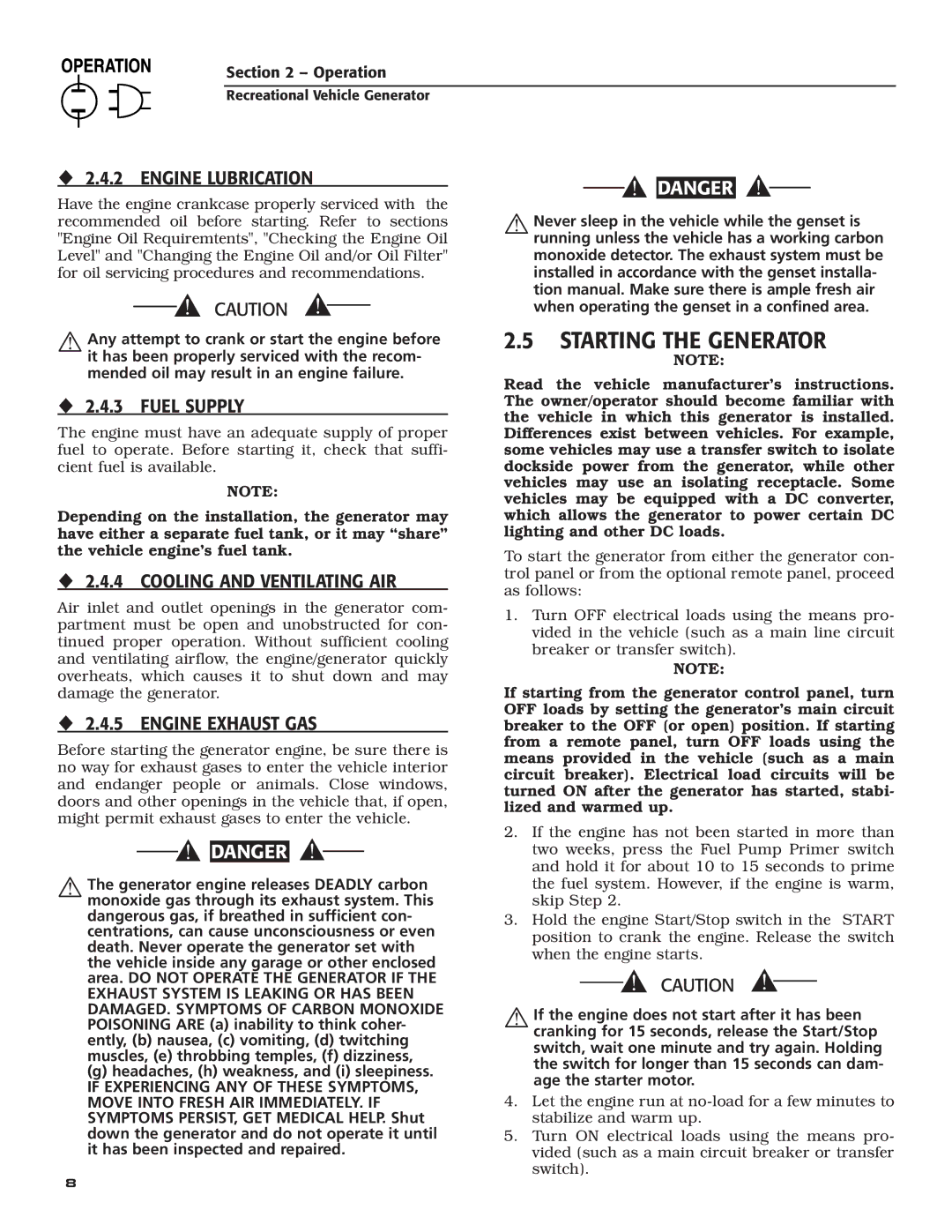
Section 2 – Operation
Recreational Vehicle Generator
2.4.2 ENGINE LUBRICATION
Have the engine crankcase properly serviced with the recommended oil before starting. Refer to sections "Engine Oil Requiremtents", "Checking the Engine Oil Level" and "Changing the Engine Oil and/or Oil Filter" for oil servicing procedures and recommendations.
Any attempt to crank or start the engine before it has been properly serviced with the recom- mended oil may result in an engine failure.
2.4.3 FUEL SUPPLY
The engine must have an adequate supply of proper fuel to operate. Before starting it, check that suffi- cient fuel is available.
NOTE:
Depending on the installation, the generator may have either a separate fuel tank, or it may “share” the vehicle engine’s fuel tank.
2.4.4 COOLING AND VENTILATING AIR
Air inlet and outlet openings in the generator com- partment must be open and unobstructed for con- tinued proper operation. Without sufficient cooling and ventilating airflow, the engine/generator quickly overheats, which causes it to shut down and may damage the generator.
2.4.5 ENGINE EXHAUST GAS
Before starting the generator engine, be sure there is no way for exhaust gases to enter the vehicle interior and endanger people or animals. Close windows, doors and other openings in the vehicle that, if open, might permit exhaust gases to enter the vehicle.
![]()
![]() DANGER
DANGER
The generator engine releases DEADLY carbon monoxide gas through its exhaust system. This dangerous gas, if breathed in sufficient con- centrations, can cause unconsciousness or even death. Never operate the generator set with the vehicle inside any garage or other enclosed area. DO NOT OPERATE THE GENERATOR IF THE EXHAUST SYSTEM IS LEAKING OR HAS BEEN DAMAGED. SYMPTOMS OF CARBON MONOXIDE POISONING ARE (a) inability to think coher- ently, (b) nausea, (c) vomiting, (d) twitching muscles, (e) throbbing temples, (f) dizziness,
(g) headaches, (h) weakness, and (i) sleepiness.
IF EXPERIENCING ANY OF THESE SYMPTOMS, MOVE INTO FRESH AIR IMMEDIATELY. IF SYMPTOMS PERSIST, GET MEDICAL HELP. Shut down the generator and do not operate it until it has been inspected and repaired.
8
![]()
![]() DANGER
DANGER
Never sleep in the vehicle while the genset is running unless the vehicle has a working carbon monoxide detector. The exhaust system must be installed in accordance with the genset installa- tion manual. Make sure there is ample fresh air when operating the genset in a confined area.
2.5 STARTING THE GENERATOR
NOTE:
Read the vehicle manufacturer’s instructions. The owner/operator should become familiar with the vehicle in which this generator is installed. Differences exist between vehicles. For example, some vehicles may use a transfer switch to isolate dockside power from the generator, while other vehicles may use an isolating receptacle. Some vehicles may be equipped with a DC converter, which allows the generator to power certain DC lighting and other DC loads.
To start the generator from either the generator con- trol panel or from the optional remote panel, proceed as follows:
1.Turn OFF electrical loads using the means pro- vided in the vehicle (such as a main line circuit breaker or transfer switch).
NOTE:
If starting from the generator control panel, turn OFF loads by setting the generator’s main circuit breaker to the OFF (or open) position. If starting from a remote panel, turn OFF loads using the means provided in the vehicle (such as a main circuit breaker). Electrical load circuits will be turned ON after the generator has started, stabi- lized and warmed up.
2.If the engine has not been started in more than two weeks, press the Fuel Pump Primer switch and hold it for about 10 to 15 seconds to prime the fuel system. However, if the engine is warm, skip Step 2.
3.Hold the engine Start/Stop switch in the START position to crank the engine. Release the switch when the engine starts.
If the engine does not start after it has been cranking for 15 seconds, release the Start/Stop switch, wait one minute and try again. Holding the switch for longer than 15 seconds can dam- age the starter motor.
4.Let the engine run at
5.Turn ON electrical loads using the means pro- vided (such as a main circuit breaker or transfer switch).
